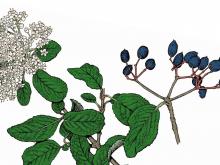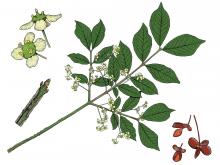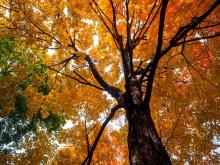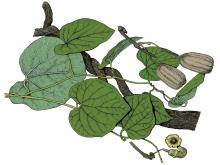Trees, Shrubs and Woody Vines
Media

Species Types
Scientific Name
Toxicodendron radicans
Description
Poison ivy is a toxic plant that contains an oil in all its parts that, if you come into contact with it, can cause an intense skin reaction. Learn to recognize it, and sidestep it on your outings.
Media

Species Types
Scientific Name
Parthenocissus vitacea (syn. P. inserta)
Description
Woodbine is a climbing woody vine that usually sprawls over bushes and rocks. Its leaves have five coarsely toothed leaflets. Unlike the closely related Virginia creeper, its tendrils generally lack sucker disks. It is rarely found in Missouri.
Media

Species Types
Scientific Name
Viburnum rufidulum
Description
Southern black haw is an irregularly branched shrub with shiny, dark green, opposite leaves whose lower surface is paler with scattered rusty hairs, especially on the veins. It bears clusters of white flowers, which turn into bluish-black fruits.
Media

Species Types
Scientific Name
Ulmus spp.
Description
Missouri has seven species of elms that grow in natural settings. Elms have tough, shock-resistant wood. In the past, some species were favorite shade trees, which is why so many towns have Elm Streets. But elms have suffered for a century from a devastating fungal disease.
Media

Species Types
Scientific Name
Fraxinus spp.
Description
Missouri has six species of ashes that you might find in natural settings. They have been very popular as shade trees, and their wood is famously useful. Ash trees of all the species in North America are currently being killed by the invasive, nonnative emerald ash borer.
Media

Species Types
Scientific Name
Euonymus alatus
Description
Burning bush, or winged euonymus, is a nonnative shrub that has been very popular in landscaping for its bright red fall foliage. But it is invasive and spreads aggressively into natural habitats, displacing native species.
Media

Species Types
Scientific Name
Acer spp.
Description
Missouri has five species of maples that are either native or naturalized, plus several that are known only in cultivation. Maples are important members of native ecosystems. They also provide stunning fall color, welcome shade in summer, commercially important lumber, and sap for syrup.
Media

Species Types
Scientific Name
Vaccinium arboreum
Description
Farkleberry, or sparkleberry, is a stiff-branched shrub or small crooked tree growing in loose thickets on rocky soils, mostly south of the Missouri River. A type of blueberry, its black fruits are edible but dry and mealy.
Media

Species Types
Scientific Name
Aristolochia tomentosa
Description
Woolly pipe-vine is a high-climbing woody vine common along streams in the Ozarks. Hikers and canoeists often don’t notice it because the leaves and unusual flowers are usually high overhead in the trees.
Media

Species Types
Scientific Name
Cocculus carolinus
Description
Carolina moonseed is a slender, twining vine. It is scattered in southern and eastern Missouri. It bears clusters of bright red, somewhat flattened fruits. The disk-shaped seeds are spiraled like a snail shell.
See Also
About Trees, Shrubs and Woody Vines in Missouri
There are no sharp dividing lines between trees, shrubs, and woody vines, or even between woody and nonwoody plants. “Wood” is a type of tissue made of cellulose and lignin that many plants develop as they mature — whether they are “woody” or not. Trees are woody plants over 13 feet tall with a single trunk. Shrubs are less than 13 feet tall, with multiple stems. Vines require support or else sprawl over the ground.





















